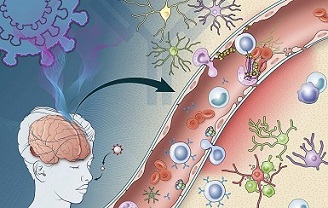Study Finds SARS-CoV-2 Spike Protein Accumulating In Skull Marrow, Brain Meninges And Brain Parenchyma While Killing Brain Cells!
COVID-19 News - Spike Protein Accumulating In Skull Marrow, Brain Meninges And Brain Parenchyma Apr 06, 2023 2 years, 2 weeks, 1 day, 3 hours, 5 minutes ago
COVID-19 News: A new study by German and Danish researchers have found the SARS-Cov-2 spike protein accumulating in skull marrow, brain meninges and brain parenchyma while killing brain cells of those who had been exposed to the spike proteins either by infection or by so called mRNA ‘prophylactics.’

The SARS-CoV-2 virus, responsible for the COVID-19 pandemic, has been associated with numerous neurological symptoms, including brain fog and brain tissue loss. These symptoms raise concerns about the acute and potential chronic impact of the virus on the central nervous system (CNS).
This study investigates the presence and distribution of the SARS-CoV-2 spike protein in the skull-meninges-brain axis using mouse models and human post-mortem tissues.
The results reveal the accumulation of the spike protein in the skull marrow, brain meninges, and brain parenchyma. Furthermore, the injection of the spike protein alone led to cell death in the brain, suggesting a direct effect on brain tissue. The study also found the presence of spike protein in the skull of deceased individuals long after their COVID-19 infection, indicating that the persistence of the spike protein may contribute to long-term neurological symptoms.
SARS-CoV-2 infection has been linked to a variety of neurological and neuropsychiatric complications, including anosmia, dysgeusia, fatigue, myalgia, depression, headache, encephalopathy, and meningitis. It also substantially increases the risk of ischemic strokes as covered in past studies and
COVID-19 News coverages. Even patients with mild COVID-19 cases often suffer from long-term effects on the brain, such as brain fog, reduced grey matter thickness, and reduced brain size.
While some studies have detected SARS-CoV-2 in brain tissue samples, others have failed to do so, leading to the hypothesis that virus-shed proteins circulating in the bloodstream may trigger an inflammatory response independent of direct viral infection of the affected organs, including the brain.
The highly immunogenic spike protein, also used in COVID-19 shots, might be a candidate for triggering infection-independent effects.
In this study, optical tissue clearing was used to identify all tissues accumulating the SARS-CoV-2 spike protein in mice and to investigate the distribution of the spike protein in post-mortem samples from COVID-19 patients.
The human proteomics data showed dysregulation of complement and coagulation cascades, neutrophil-related pathways, and an upregulation of pro-inflammatory proteins. Injecting spike protein directly into the skull marrow niches of healthy mice triggered proteome changes and cell death in the brain parenchyma.
Surprisingly, lingering spike protein was identified in the skull samples of a subset of individuals who had recovered from COVID-19 and died due to non-COVID-related causes.
The accumulation of SARS-CoV-2 spike protein at the CNS borders suggests that it can contribute to changes in the brain, providing a possible mechanism for the neurological effects of SARS-CoV-2 infection. The dysregulation of coronavirus disease, co
mplement activation, and PI3K-AKT pathways in the skull, meninges, and brain tissue demonstrated a common effect of SARS-CoV-2 infections on the immune system along the skull-meninges-brain axis. These molecules or molecular pathways can be leveraged as therapeutic targets to prevent or treat brain-related complications in COVID-19.
The study also suggests a potential mechanism for the virus's entry into the CNS. In both mouse and COVID-19 human tissues, spike protein was found in the skull-meninges connection (SMC), which the virus or virus components could use to travel from the skull marrow to the meninges and the brain parenchyma.
However, more data is needed to establish the most common route of brain invasion by SARS-CoV-2, which might differ between different parts of the brain.
Brain invasion of virus-shed spike protein found in some COVID-19 cases has been linked to a compromised blood-brain barrier and trafficking along the olfactory nerve or vagus nerve.
Here, the study team suggest an alternative scenario wherein SARS-CoV-2 spike protein reaches first the skull marrow and then the meninges before entering the brain. Spike-induced alterations in the skull-meninges-brain axis present diagnostic and therapeutic opportunities as both skull and meninges are easier to access than brain parenchyma. Panels of such proteins tested in plasma samples of COVID-19 patients might provide an early prognosis of brain-related complications.
Future efforts will be committed to characterizing these proteins towards their use as biomarkers and therapeutic targets for neurological dysfunction in COVID-19 infections.
In conclusion, this study sheds light on the potential mechanisms underlying the immediate and long-term consequences of SARS-CoV-2 infection on the central nervous system. The accumulation of the SARS-CoV-2 spike protein in the skull marrow, brain meninges, and brain parenchyma highlights the importance of considering the broader implications of COVID-19 on neurological health. The identification of differentially regulated pathways and proteins in these tissues provides valuable insights for future research and potential therapeutic interventions.
The findings emphasize the need for continued research on the neurological implications of COVID-19, particularly in relation to the SARS-CoV-2 spike protein and its accumulation in the skull-meninges-brain axis. As more is learnt about the mechanisms underlying these neurological complications, scientists can develop better diagnostic tools and treatments for individuals suffering from the long-term effects of COVID-19 on the brain.
Finally, the persistence of the spike protein in the skull marrow and brain tissues even after recovery from COVID-19 raises questions about the potential long-term effects of the virus on neurological health. This observation warrants further investigation and highlights the importance of long-term follow-up for individuals who have recovered from COVID-19. Understanding the potential long-term consequences of the virus on the central nervous system is essential for providing appropriate care and support for those affected by the pandemic.
The study findings were published on a preprint server and are currently being peer reviewed.
https://www.biorxiv.org/content/10.1101/2023.04.04.535604v1
For the latest
COVID-19 News, keep on logging to Thailand Medical News.
